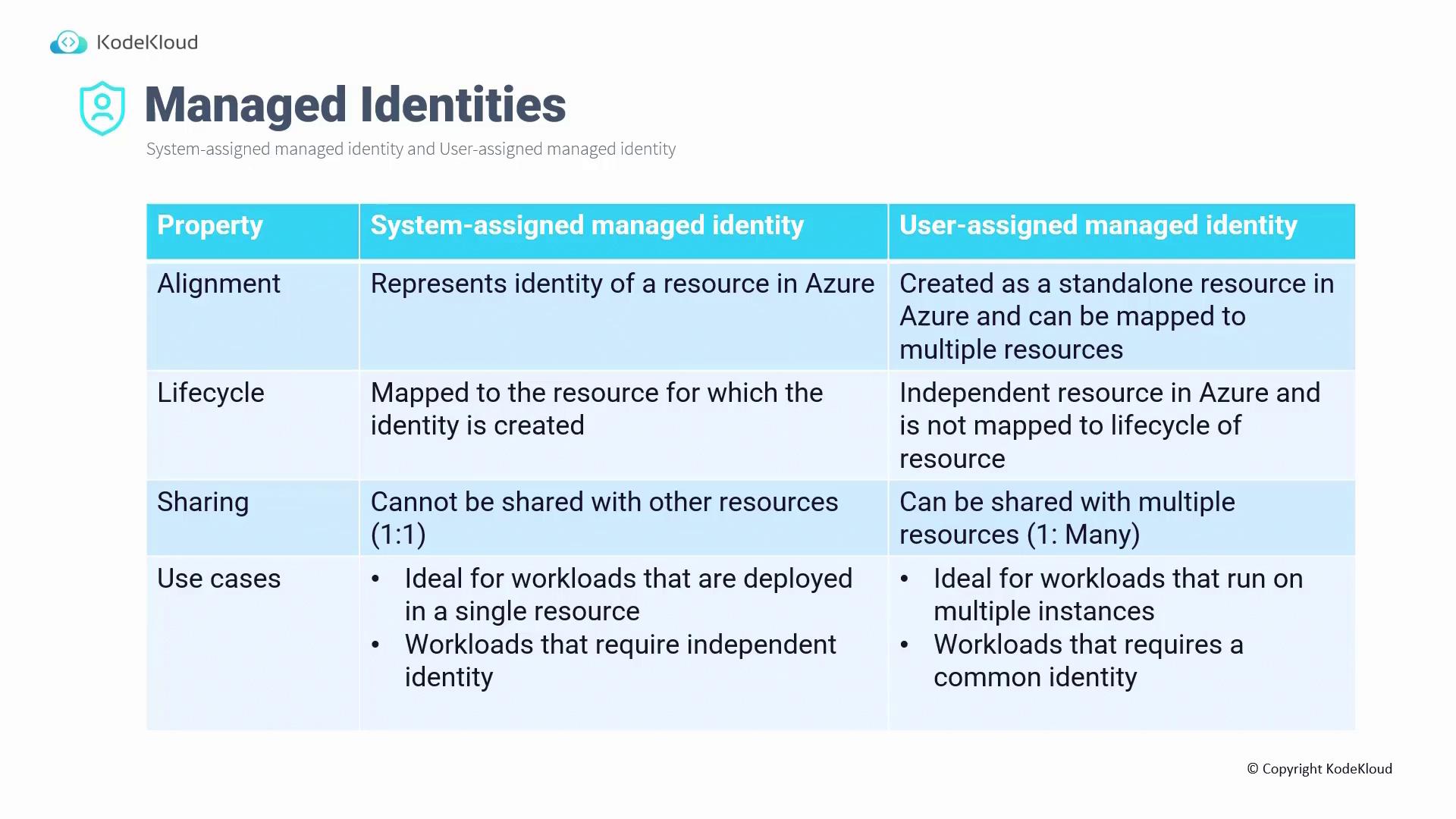AZ-305: Microsoft Azure Solutions Architect Expert
Design for authentication and authorization
Design for managed identities
Managed identities provide a secure and efficient way for your Azure resources to authenticate with Azure Active Directory (Azure AD) and access other services without embedding credentials in your code. This guide explains how managed identities work and demonstrates connecting to an Azure SQL Database using both traditional credential-based authentication and managed identity authentication.
Traditional Credential-Based Authentication
In a traditional setup, a Python web application running on Azure connects to an SQL Database using a username and password stored within the code. While this method may work, it exposes sensitive credentials that could be compromised if the code is accidentally pushed to a public repository.
import pyodbc
server = "mykodekloud.database.windows.net"
database = "products"
username = "dbadmin"
password = "VeryStrongPassword#889"
driver = "{ODBC Driver 17 for SQL Server}"
with pyodbc.connect(
"DRIVER=" + driver +
";SERVER=tcp:" + server +
";PORT=1433;" +
"DATABASE=" + database +
";UID=" + username +
";PWD=" + password
) as conn:
with conn.cursor() as cursor:
cursor.execute("SELECT TOP 3 name, collation_name FROM sys.databases")
row = cursor.fetchone()
while row:
print(str(row[0]) + " " + str(row[1]))
row = cursor.fetchone()
Warning
Storing clear-text credentials in your code is risky. If the repository is ever breached, sensitive information can be easily stolen.
Managed Identity Authentication
Managed identities remove the need to store credentials in your code. Instead, your Azure resource is granted an identity in Azure AD, which can then obtain an authentication token to access services such as Azure SQL Database.
The following example demonstrates how to connect to an Azure SQL Database using a managed identity. Notice that the connection string uses Active Directory MSI (Managed Service Identity) and obtains a token from Azure AD for secure authentication.
import pyodbc
import struct
server = "mykodekloud.database.windows.net"
database = "products"
driver = "{ODBC Driver 17 for SQL Server}"
connection_string = (
"DRIVER=" + driver +
";SERVER=" + server +
";DATABASE=" + database
)
# Establish a connection using ActiveDirectoryMsi authentication.
_conn = pyodbc.connect(connection_string + ";Authentication=ActiveDirectoryMsi")
# Assume 'exptoken' is a byte string containing the access token obtained from Azure AD.
# The following constructs the token structure required by pyodbc.
tokenstruct = struct.pack("=I", len(exptoken)) + exptoken
# Create a connection using the token
conn = pyodbc.connect(connection_string, attrs_before={SQL_COPT_SS_ACCESS_TOKEN: tokenstruct})
with conn.cursor() as cursor:
cursor.execute("SELECT TOP 3 name, collation_name FROM sys.databases")
row = cursor.fetchone()
while row:
print(row[0], row[1])
row = cursor.fetchone()
By using managed identity authentication, there is no need to hard-code a username or password. Instead, Azure AD returns a token for the managed identity, ensuring secure and streamlined access to your SQL database or any other service that supports Azure AD authentication.
Use Cases for Managed Identities
Managed identities can be used in various scenarios where secure resource authentication is required. They are supported by several Azure resources, including:
- Virtual Machines
- Web Apps
- Azure Kubernetes Service (AKS)
- Function Apps
- Load Balancers
Note
Managed identities are only available for resources deployed in Azure. They cannot be used with on-premises applications.
Using managed identities eliminates the need for constant credential rotations or certificate management, as the identity is maintained automatically by Azure AD. This significantly enhances the security and manageability of your applications.
Types of Managed Identities
There are two types of managed identities in Azure:
System-Assigned Managed Identity:
This identity is automatically created for an Azure resource (e.g., a virtual machine). The identity's lifecycle is tied to the resource; if the resource is deleted, the identity is also removed.User-Assigned Managed Identity:
This is a standalone identity resource that you create in Azure. It can be assigned to multiple Azure resources, making it ideal for scenarios where different instances of your application require a common identity.
Below is a diagram comparing the two types of managed identities:

Key Differences Between Managed Identity Types
Lifecycle:
• System-assigned identities are deleted automatically with their resource.
• User-assigned identities exist independently of the resources that use them.Sharing:
• System-assigned identities are dedicated to a single resource (one-to-one relationship).
• User-assigned identities can be shared across multiple resources.Use Cases:
• Choose system-assigned identities for workloads confined to a single resource.
• Choose user-assigned identities when multiple resources require a shared identity.
Demo scenarios include a virtual machine connecting to a database, a web app accessing data, or an application gateway retrieving an SSL certificate from Key Vault. In each case, managed identities offer a secure and maintainable method of authentication.
Integration with Azure Key Vault
Next, we explore how Azure Key Vault integrates with managed identities to further enhance your security management by providing secure storage and access to certificates, secrets, and keys.
For more information on Azure AD and role-based access control, please visit the following resources:
By leveraging managed identities and Azure AD, you can significantly reduce the risk associated with credential management, ensuring your applications remain secure and compliant with modern security standards.
Watch Video
Watch video content